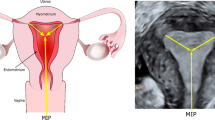Abstract
Background
To analyze the effects of embryo transfer (ET) quality on clinical pregnancy (CPR) and live birth delivery rates (LBDR).
Methods
In a retrospective study at a single, private infertility center between November 2005 and December 2009 one thousand fifty-five day-3 and day-5 ETs following IVF/ICSI/IMSI were evaluated. We analyzed the impact of an atraumatic ET with a soft catheter (ET 1), after external guidance (ET 2), after probing of the cervix with a stylet (ET 3), or after grasping the portio vaginalis with a tenaculum (ET 4) on CPR and LBDR.
Results
The use of external guidance showed a significantly reduced LBDR as compared to an atraumatic ET (26.0% vs. 32.5%). The lowest CPR and LBDR were found in ET 4. The application of stylets in cases of difficult ETs was superior to the use of external guidance. No differences in miscarriages between ET 1–4 were noted.
Conclusions
Besides embryo culture and patient history, the quality of an ET might also have an important impact on pregnancy outcome. Techniques to ensure an atraumatic ET, such as mechanic uterine cavity length measurements, before starting treatment might help identify patients at risk for a difficult ET and lead to modified treatments, such as the primary use of a stylet. Limitation of study: retrospective analysis
Similar content being viewed by others
References
Cohen J. Embryo replacement technology. San Francisco 31 Annual post graduate course. ASRM. 1989
Mains L, Van Voorhis BJ. Optimizing the technique of embryo transfer. Fertil Steril. 2010;94:785–90.
Kovacs GT. What factors are important for successful embryo transfer after in-vitro fertilization? Hum Reprod. 1999;14:590–2.
Lass A, Abusheikha N, Brinsden P. The effect of a difficult embryo transfer on the outcome of IVF. Hum Reprod. 1999;14:2417.
Lesny P, Killick SR, Robinson J, Raven G, Maguisness SD. Junctional zone contractions and embryo transfer: is it safe to use a tenaculum? Hum Reprod. 1999;14:2367–70.
Lesny P, Killick SR, Tetlow RL, Robinson J, Maguisness SD. Embryo transfer—can we learn anything new from the observation of junctional zone contractions? Hum Reprod. 1998;13:1540–6.
Biervliet FP, Lesny P, Maguiness SD, Killick SR. Ultrasound-guided embryo transfer maximizes the IVF results on day 3 and day 4 embryo transfer but has no impact on day 5. Hum Reprod. 2002;17:1131–2.
Fanchin R, Ayoubi J-M, Righini C, Olivennes F, Schönauer LM, Frydman R. Uterine contractility decreases at the time of blastocyst transfer. Hum Reprod. 2001;16:1115–9.
Fanchin R, Righini C, Olivennes F, Taylor S, De Ziegler D, Frydman R. Uterine contractility decreases at the time of blastocyst transfer. Hum Reprod. 1998;13:1968–74.
Gardner DK, Schoolcraft WB. In vitro culture of human blastocysts. In: Jansen R, Mortimer D, editors. Towards reproductive certainty: infertility and genetics beyond 1999. Carnforth: Parthenon Press; 1999. p. 378–88.
Puissant F, Van Rysselberge M, Barlow P, Deweze J, Leroy F. Embryo scoring as a prognostic tool in IVF treatment. Hum Reprod. 1987;2:705–8.
Zegers-Hochschild F, Adamson GD, de Mouzon J, Ishihara O, Mansour R, Nygren K, Sullivan E, van der Poel S, on behalf of ICMART and WHO. The International Committee for Monitoring Assisted Reproductive Technology (ICMART) and the World Health Organization (WHO) revised glossary on ART terminology, 2009†. Hum Reprod. 2009;11:2683–7.
Spandorfer SD, Goldstein J, Navarro J, Veeck L, Davis OK, Rosenwaks Z. Difficult embryo transfer has a negative impact on the outcome of in vitro fertilization. Fertil Steril. 2003;79:654–5.
Drakeley A, Jorgensen A, Sklavounos J, Aust T, Gazvani R, Williamson P, et al. A randomized controlled clinical trial of 2295 ultrasound-guided embryo transfers. Hum Reprod. 2008;23:1101–6.
Tur-Kaspa I, Yuval Y, Bider D, Levron J, Shulman A, Dor J. Difficult or repeated sequential embryo transfer do not adversely affect in-vitro fertilization pregnancy rates or outcome. Hum Reprod. 1998;13:2452–5.
Gardner DK, Schoolcraft WB, Wagley L, Schlenker T, Stevens J, Hesla J. A prospective randomized trial of blastocyst culture and transfer in in-vitro fertilization. Hum Reprod. 1998;12:3434–40.
Papanikolaou E, Camus M, Kolibianakis M, Van Landuyt L, Van Steirteghem A, Devroey P. In vitro fertilization with single blastocyst-stage versus single cleavage-stage embryos. N Engl J Med. 2006;354:1139–46.
Zech NH, Lejeune B, Puissant F, Vanderzwalmen S, Zech H, Vanderzwalmen P. Prospective evaluation of the optimal time for selecting a single embryo for transfer: day 3 versus day 5. Fertil Steril. 2007;88:244–6.
Angelini A, Brusco GF, Barnocchi N, El-Danasouri I, Pacchiarotti A, Selman HA. Impact of physician performing embryo transfer on pregnancy rates in an assisted reproductive program. J Assist Reprod Genet. 2006;23:329–32.
Financial support
None
Conflicts of interest
None
Author information
Authors and Affiliations
Corresponding author
Additional information
The authors have nothing to disclose.
Capsule
The quality of embryo transfer (ET) might have an impact on pregnancy outcome. Techniques to ensure an atraumatic ET before starting an IVF cycle might help in optimizing the treatment of patients.
Rights and permissions
About this article
Cite this article
Spitzer, D., Haidbauer, R., Corn, C. et al. Effects of embryo transfer quality on pregnancy and live birth delivery rates. J Assist Reprod Genet 29, 131–135 (2012). https://doi.org/10.1007/s10815-011-9680-z
Received:
Accepted:
Published:
Issue Date:
DOI: https://doi.org/10.1007/s10815-011-9680-z



